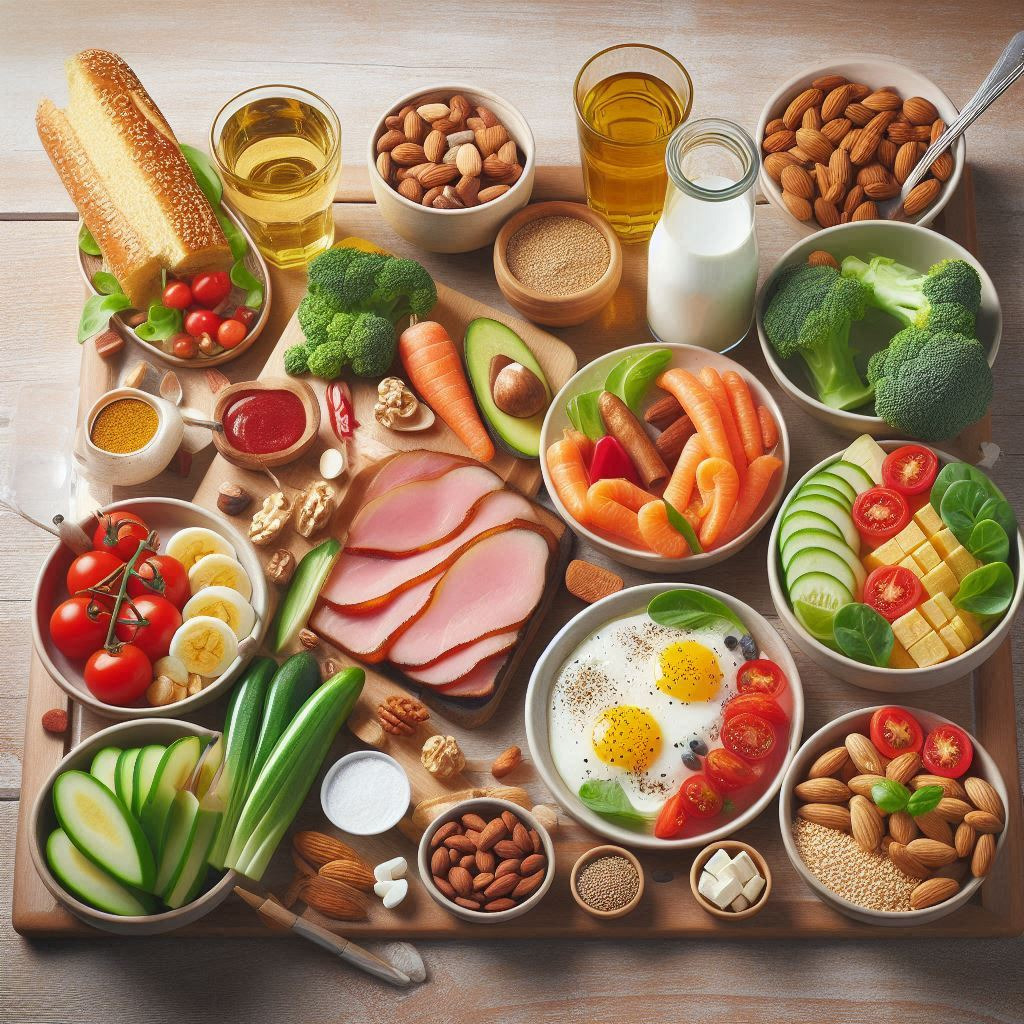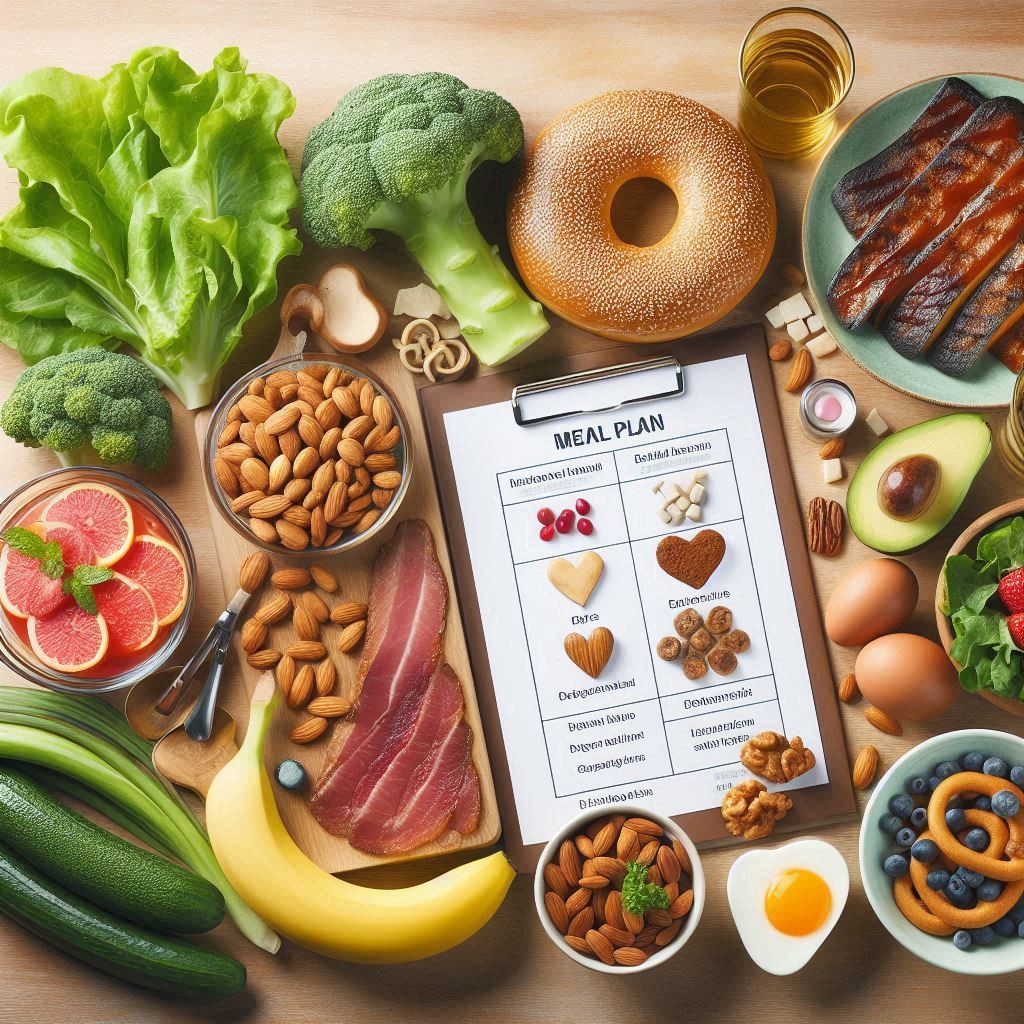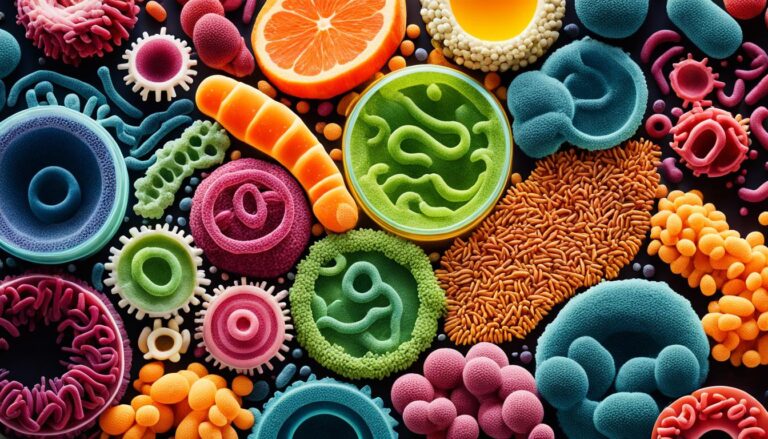Lowering triglyceride levels is essential for maintaining good heart health. Triglycerides, a type of fat found in the blood, can increase the risk of heart disease if they are too high. A healthy 7-day meal plan to help lower triglycerides can be a great tool in achieving this goal. By incorporating nutritious foods and making smart dietary choices, you can effectively lower your triglyceride levels and improve your overall well-being. In this article, we will provide expert advice on creating a 7-day meal plan to help lower triglycerides, ensuring that you have all the knowledge and resources necessary to make positive changes in your diet. So, let’s dive in and start this journey towards a healthier you!
Understanding Triglycerides and Their Impact on Heart Health
Triglycerides, a type of fat found in the blood, play a significant role in our overall heart health. While some triglycerides are essential for providing energy, high levels can increase the risk of heart disease. Understanding triglycerides and their impact on our heart health is crucial for maintaining a healthy lifestyle.
When we consume more calories than our body needs, the excess is converted into triglycerides and stored in fat cells. These stored triglycerides are released into the bloodstream when our body requires energy between meals. However, consistently high triglyceride levels, often caused by a diet high in sugar, refined carbohydrates, and fatty foods, can contribute to heart disease.
The good news is that by making a few dietary changes, we can lower our triglyceride levels and improve heart health. Incorporating heart-healthy fats like avocados, olive oil, and fatty fish into our diet can help lower triglycerides. Additionally, choosing whole grains, fruits, and vegetables over processed foods can have a positive impact.
To get started, here’s a simple 7-day meal plan to help lower triglycerides. For breakfast, enjoy oatmeal with a handful of berries and a sprinkle of chia seeds. For lunch, opt for a salad packed with leafy greens, grilled chicken or tofu, and a drizzle of olive oil. Snack on a handful of almonds or an apple with peanut butter in the afternoon, and for dinner, indulge in grilled salmon with steamed broccoli and quinoa. Remember to drink plenty of water throughout the day and limit alcohol consumption.
In conclusion, understanding the impact of triglycerides on our heart health is essential for maintaining a healthy lifestyle. By making simple dietary changes, like incorporating heart-healthy fats and whole foods, we can lower our triglyceride levels and reduce the risk of heart disease. So, let’s commit to making these food choices and start taking care of our heart today.
Day 1: Kickstart Your Lowering Triglycerides Journey with Healthy Choices
If you’ve recently discovered that you have high triglyceride levels, don’t panic. There are steps you can take to lower your triglycerides and improve your overall health. It all starts with making healthy choices.
On Day 1, kickstart your lowering triglycerides journey by following a 7-day meal plan designed to help lower triglycerides. This meal plan includes nutrient-rich foods that are low in saturated fats and sugars. Incorporating these foods into your diet can have a significant impact on reducing your triglyceride levels.
Start your day off right with a hearty breakfast consisting of oatmeal topped with fresh berries and a sprinkle of nuts. Oatmeal is rich in soluble fiber, which helps to lower triglycerides. Berries are packed with antioxidants that protect against inflammation and heart disease. Nuts, like almonds or walnuts, contain heart-healthy fats that can help to balance your triglyceride levels.
As you move through the day, strive to include lean proteins such as fish, skinless poultry, or tofu in your meals. These protein sources are low in saturated fats and can help to lower triglycerides. Accompany your protein with plenty of non-starchy vegetables, which are high in fiber and essential nutrients. Additionally, incorporate healthy fats from sources like avocados and olive oil, as they have been shown to have a positive effect on triglycerides.
Throughout this 7-day journey, remember to stay hydrated by drinking plenty of water. Avoid sugary beverages and replace them with herbal teas or infused water for added flavor. Physical activity is also crucial, so aim for at least 30 minutes of moderate exercise each day, such as brisk walking or cycling.
By making these healthy choices and following the 7-day meal plan to help lower triglycerides, you’re taking a proactive step towards improving your heart health. Stick to these habits beyond day 1, and you’ll soon see a positive impact on your triglyceride levels. Remember, consistency is key, and the journey to lower triglycerides starts with the choices you make each day.
Day 2: Building a Balanced Plate to Combat High Triglyceride Levels
When it comes to managing high triglyceride levels, a balanced diet is key. On the second day of our 7-day meal plan to help lower triglycerides, we will focus on building a plate that promotes heart health and reduces the risk of cardiovascular diseases. By incorporating nutrient-rich foods and controlling portion sizes, we can make significant progress in improving our lipid profile.
To start, let’s focus on lean proteins. Opt for skinless poultry, fish, and plant-based proteins such as lentils or tofu. These options are low in saturated fats and high in essential nutrients like omega-3 fatty acids, which have been shown to lower triglyceride levels. Pair your protein with a generous serving of non-starchy vegetables like leafy greens, broccoli, and peppers. These vegetables are packed with fiber, vitamins, and minerals that support heart health.
Next, let’s talk about whole grains. Replace refined grains like white rice or white bread with whole grains, such as quinoa, brown rice, or whole wheat bread. Whole grains are rich in fiber and have a lower glycemic index, which means they won’t cause a sudden spike in blood sugar levels. This is important because high blood sugar can contribute to elevated triglyceride levels. Incorporating whole grains into your meals will not only provide necessary nutrients but also help control triglycerides.
Lastly, don’t forget the healthy fats. Incorporate sources of unsaturated fats, such as olive oil, avocado, nuts, and seeds, into your diet. These fats can help raise HDL (good) cholesterol levels while reducing triglycerides. Be mindful of portion sizes, as fats are calorie-dense, and excess calories can contribute to weight gain, which may worsen triglyceride levels.
By building a balanced plate that focuses on lean proteins, non-starchy vegetables, whole grains, and healthy fats, we can take significant steps in combating high triglyceride levels. Remember to consult with a healthcare professional or a registered dietitian to tailor a meal plan that meets your specific needs. Stay tuned for more tips and ideas to continue your journey towards a healthier lipid profile in the coming days.
Day 3: Incorporating Heart-Healthy Fats into Your Diet
Welcome back to our 7-day meal plan to help lower triglycerides. On day 3, we will focus on incorporating heart-healthy fats into our diets. While it may seem counterintuitive to eat fats when trying to improve heart health, not all fats are created equal. In fact, certain fats can have numerous benefits, such as reducing inflammation and aiding in the absorption of vitamins.
Start off your day with a delicious and nutritious avocado toast. Avocados are packed with monounsaturated fats, which have been shown to lower bad cholesterol levels. Simply spread a ripe avocado on whole-grain toast and sprinkle some salt and pepper. To add some extra nutrients, top it off with sliced tomatoes or a poached egg.
For lunch, opt for a salad with a drizzle of olive oil-based dressing. Olive oil is rich in antioxidants and monounsaturated fats. Toss a variety of colorful vegetables, such as leafy greens, tomatoes, cucumber, and bell peppers, and dress it with a mixture of olive oil, lemon juice, garlic, and herbs. Adding some lean protein like grilled chicken or chickpeas can make it a complete and satisfying meal.
When it comes to dinner, consider incorporating fatty fish such as salmon or trout into your meal. These types of fish are high in omega-3 fatty acids, which have been shown to reduce inflammation and promote heart health. Bake or grill a piece of fish and serve it with a side of steamed vegetables and a whole grain, like quinoa or brown rice.
By incorporating heart-healthy fats into our meals, we can support our heart health while still enjoying delicious and satisfying foods. Remember, moderation is key, so be mindful of portion sizes and balance your meals with other nutritious ingredients. Stay tuned for day 4 of our 7-day meal plan, where we will focus on incorporating antioxidants into our diet.
Day 4: Exploring Nutrient-Dense Foods for Triglyceride Management
Welcome to day 4 of our series on managing triglycerides through a nutrient-dense diet. In the previous days, we covered the basics of understanding triglycerides and how certain lifestyle factors can impact their levels. Today, we will delve into the world of nutrient-dense foods that can help lower triglycerides.
When it comes to managing triglycerides, consuming a variety of nutrient-dense foods is crucial. These foods not only provide essential vitamins and minerals but are also low in saturated fats and high in fiber. Incorporating these foods into your diet can have a positive impact on your triglyceride levels.
Some examples of nutrient-dense foods that can potentially help lower triglycerides include fatty fish such as salmon and mackerel, which are rich in omega-3 fatty acids. These healthy fats have been shown to reduce inflammation and lower triglyceride levels. Other options include whole grains, such as oats and brown rice, which are high in fiber and can help regulate blood sugar levels. Additionally, incorporating fruits and vegetables, such as berries, leafy greens, and avocados, can provide essential nutrients and antioxidants that support heart health.
To make it easier for you to incorporate these foods into your daily routine, we have designed a 7-day meal plan to help lower triglycerides. This meal plan includes a variety of nutrient-dense recipes that are both delicious and nutritious. By following this plan, you can discover new flavors while working towards managing your triglyceride levels.
Remember, managing triglycerides requires a holistic approach that includes regular exercise, stress management, and a well-balanced diet. By incorporating nutrient-dense foods into your daily meals, you can take a step towards optimal health and well-being. Stay tuned for our next article, where we will discuss the importance of exercise in triglyceride management.
Day 5: Adding Fiber-Rich Foods for Optimal Triglyceride Reduction
If you’re seeking to reduce your triglyceride levels, incorporating fiber-rich foods into your diet is a crucial step towards achieving optimal results. Fiber plays a significant role in lowering triglycerides as it slows down digestion, preventing spikes in blood sugar levels. Moreover, fiber binds with cholesterol in the digestive tract, reducing the absorption of fats into the bloodstream.
To help you get started on your journey to lower triglycerides, we have crafted a 7-day meal plan that includes a variety of fiber-rich foods. Begin your day with a breakfast of oatmeal topped with fresh berries and a sprinkling of flaxseeds. Oats are not only rich in soluble fiber but also contain beta-glucans, which have been found to reduce triglyceride levels.
For a mid-morning snack, munch on a handful of almonds, which are packed with fiber, healthy fats, and antioxidants. Lunch can feature a hearty salad with a base of leafy greens, topped with grilled salmon or chicken for lean protein. Add in some sliced avocado, cherry tomatoes, and a drizzle of olive oil for healthy fats and additional fiber.
In the afternoon, indulge in some crunchy vegetables like baby carrots, bell peppers, or cucumber slices, along with a side of hummus for a tasty and fiber-rich snack. For dinner, opt for a bowl of vegetable curry with brown rice or whole wheat pasta. The variety of vegetables in the curry not only provide fiber but also essential vitamins and minerals for overall health.
By following this 7-day meal plan, you can kickstart your journey towards optimal triglyceride reduction. Remember to drink plenty of water throughout the day to keep your body hydrated and support digestion. With commitment and a focus on fiber-rich foods, you can achieve healthier triglyceride levels and improve your overall well-being.In today’s article, we will be discussing the importance of incorporating fiber-rich foods into your diet to help lower triglyceride levels. As triglycerides are a type of fat found in the blood, high levels can increase the risk of heart disease and other health issues. By making simple dietary adjustments and following a 7-day meal plan designed to lower triglycerides, you can take proactive steps towards a healthier lifestyle.
Fiber is a nutrient that is not only essential for digestive health but also plays a crucial role in reducing triglycerides. It helps slow down the absorption of sugar, which in turn can lower insulin levels and ultimately decrease triglyceride production. Including foods such as fruits, vegetables, legumes, and whole grains in your diet can significantly boost your fiber intake.
When planning your meals, aim to incorporate at least 25-30 grams of fiber per day, as recommended by dietary guidelines. Start your day with a bowl of oatmeal topped with fresh berries or a high-fiber cereal option to kickstart your fiber intake. Throughout the day, incorporate snacks like almonds or carrots and hummus to maintain a steady fiber intake. For lunch and dinner, opt for meals that are centered around fiber-rich vegetables, lean proteins, and whole grains.
Remember to hydrate your body throughout the day by drinking plenty of water, as it supports digestion and overall health. By committing to a fiber-focused meal plan, you can not only lower your triglyceride levels but also improve your overall well-being. Take control of your health today and start implementing these changes for a better tomorrow.

In today’s fast-paced world, where convenience often trumps health, it’s easy for our diets to spiral out of control. One of the key culprits behind this dietary chaos is the surge in triglyceride levels, which can lead to serious health issues if left unattended. Triglycerides are a type of fat found in the blood, and high levels can increase the risk of heart disease, stroke, and diabetes. But fear not, there is light at the end of the tunnel! By making a few dietary adjustments, you can significantly lower your triglyceride levels and improve your overall health. This 7-day meal plan to help lower triglycerides is here to give you expert advice on incorporating delicious, nutrient-rich foods into your diet and saying goodbye to those harmful fats. Prepare to embark on a journey toward a healthier you!
Understanding Triglycerides: What You Need to Know
Triglycerides, a type of fat found in the blood, play a crucial role in our health. While some amount of triglycerides is essential for our body’s normal functioning, high levels can lead to various health problems, including heart disease. Understanding triglycerides is essential for maintaining good health and preventing such complications.
Triglycerides are primarily derived from the fats and carbohydrates we consume. When we eat more calories than our body needs, the excess is converted into triglycerides and stored in fat cells. In addition to dietary sources, our liver also produces triglycerides. These fats serve as a source of energy when required. However, elevated levels of triglycerides can accumulate in the blood and increase the risk of heart disease, especially when combined with high levels of bad cholesterol.
Lowering triglyceride levels is paramount for reducing the risk of heart disease. Adopting a healthy lifestyle that includes regular physical activity, weight management, and a balanced diet is crucial. A diet rich in fruits, vegetables, whole grains, lean proteins, and healthy fats can help lower triglyceride levels. Including omega-3 fatty acids, found in fatty fish like salmon, in your diet is also beneficial.
A 7-day meal plan to help lower triglycerides can be a great starting point towards achieving a healthier lifestyle. This plan should focus on incorporating heart-healthy foods and limiting saturated and trans fats, added sugars, and refined carbohydrates. Including foods like nuts, seeds, avocados, olive oil, and fatty fish can help raise good cholesterol levels and lower triglycerides. Gradually reducing portion sizes, avoiding processed foods, and cutting back on alcohol consumption are also crucial steps in managing triglyceride levels.
In conclusion, understanding triglycerides is key to maintaining good heart health. By adopting a healthy lifestyle and following a well-balanced diet, you can effectively lower triglyceride levels. Consider consulting with a healthcare professional or a registered dietitian to create a personalized meal plan that suits your specific needs. Remember, small changes can make a big difference in your overall health and well-being.
Day 1: Kickstart Your Health Journey with a Nutrient-Packed Breakfast
Are you ready to take control of your health and start your wellness journey? It all begins with a nutrient-packed breakfast, setting the tone for a day filled with energy and vitality. Starting Day 1 of your health journey with a wholesome breakfast will not only kickstart your metabolism but also provide you with essential nutrients to fuel your day.
Including foods rich in vitamins, minerals, and antioxidants in your breakfast can have profound effects on your overall well-being. A well-balanced meal can help lower triglycerides, a type of fat found in the blood that can increase the risk of heart disease. Incorporating the right foods into your breakfast can be a step towards achieving optimal health.
To help you get started on your health journey, here’s a delicious and nutritious breakfast idea for Day 1: a green smoothie bowl. Packed with leafy greens, fruits, and healthy fats, this breakfast is not only visually appealing but also brimming with essential nutrients. Combine a handful of spinach or kale, a frozen banana, a tablespoon of almond butter, and a splash of almond milk in a blender. Blend until smooth, and then pour it into a bowl. Top it with your favorite fruits, nuts, and seeds for an added crunch.
By incorporating this breakfast into your daily routine and following a 7-day meal plan designed to help lower triglycerides, you can jumpstart your health journey. Remember, a healthy start to the day will set the tone for a healthier you. Take the first step and enjoy a nutrient-packed breakfast today!
Day 2: Lunch Ideas to Keep Your Triglycerides in Check
In our ongoing series of creating a heart-healthy lifestyle, we’re now on Day 2. Today, we’ll be diving into lunch ideas that can help keep your triglycerides in check. As we mentioned previously, high triglyceride levels can contribute to heart disease and other cardiovascular problems. But don’t worry, we’ve got you covered with a delicious and nutritious 7-day meal plan to help lower triglycerides.
For a satisfying and low triglyceride lunch option, try a grilled salmon salad. Salmon is rich in omega-3 fatty acids, which have been shown to reduce triglyceride levels. Combine grilled salmon with a variety of fresh vegetables like spinach, tomatoes, cucumbers, and bell peppers. Top it off with a light vinaigrette dressing made with olive oil, lemon juice, and herbs.
Another great lunch idea is a whole grain wrap filled with lean proteins and veggies. Swap out the white flour tortilla for a whole wheat or whole grain wrap, and fill it with lean turkey or chicken, along with lettuce, tomato, and avocado. This combination will provide you with a good balance of protein, healthy fats, and fiber, all of which can help lower triglyceride levels.
If you prefer a warm lunch option, go for a hearty vegetable and bean soup. Beans are an excellent source of fiber and protein, which can help regulate triglyceride levels. Combine a variety of colorful vegetables like carrots, celery, zucchini, and spinach with your choice of beans, such as lentils or chickpeas. Simmer them together with flavorful herbs and spices for a nutritious and filling lunch.
With these lunch ideas, you can fuel your body while keeping your triglycerides in check. Remember, a well-balanced and heart-healthy diet is essential for overall well-being. Stay tuned for more tips and recipes as we continue our 7-day meal plan to help lower triglycerides.
Day 3: Delicious Dinner Options for Lowering Triglycerides
In today’s article, we will explore some delicious dinner options that can help you lower your triglycerides. As part of our 7-day meal plan to help lower triglycerides, dinner plays a crucial role in maintaining a healthy lifestyle. By incorporating these options into your diet, you can not only enjoy a tasty meal but also take a step towards improving your heart health.
One option for a triglyceride-friendly dinner is grilled salmon with roasted vegetables. Salmon is rich in omega-3 fatty acids, which have been shown to reduce triglyceride levels. Combined with a side of roasted vegetables like broccoli and Brussels sprouts, this meal is not only nutritious but also packed with flavor.
Another delicious dinner option is a quinoa-stuffed bell pepper. Quinoa is a whole grain that contains high amounts of fiber and plant-based protein. By stuffing a bell pepper with quinoa, vegetables, and herbs, you create a satisfying meal that is low in cholesterol and can help lower triglycerides.
For those who prefer a vegetarian option, you can indulge in a vegetable stir-fry with tofu. Stir-frying vegetables like bell peppers, mushrooms, and snap peas, along with tofu for protein, creates a well-balanced meal that is both heart-healthy and scrumptious.
Remember, these dinner options are just a few examples from our 7-day meal plan to help lower triglycerides. By incorporating a variety of heart-healthy ingredients into your daily meals, you can make significant progress in maintaining healthy triglyceride levels. So, go ahead and enjoy these delicious dinner options while taking care of your heart.
Snack Smart: Healthy Options to Support Your Triglyceride-Lowering Goals
Looking for healthy snack options to support your triglyceride-lowering goals? Look no further! Making smart choices when it comes to snacks can have a big impact on your overall health. Triglycerides are a type of fat found in your blood, and high levels can increase your risk of heart disease. Incorporating nutrient-dense options into your diet can help lower your triglycerides and improve your heart health.
To start your journey towards healthier snacking, consider incorporating foods that are rich in omega-3 fatty acids. Examples include fatty fish like salmon and tuna, as well as walnuts and flaxseeds. These foods not only provide heart-healthy fats but also offer other health benefits like reducing inflammation and supporting brain health.
Another great option is to choose snacks that are high in fiber. Foods like whole grain crackers, fruits, and vegetables can help regulate your blood sugar levels and keep you feeling full. This can prevent overeating and reduce the risk of weight gain, which is another factor that can contribute to high triglyceride levels.
If you’re looking for a structured approach, consider following a 7-day meal plan to help lower triglycerides. This plan can provide you with a variety of nutritious meals and snacks that specifically target the reduction of triglyceride levels. It typically includes foods like lean proteins, whole grains, fruits, vegetables, and healthy fats. Consulting with a registered dietitian can help you customize a meal plan that works best for your dietary needs and preferences.
In conclusion, snacking smart and making healthy choices can have a big impact on your triglyceride levels and overall heart health. Incorporate foods rich in omega-3 fatty acids and high in fiber, and consider following a structured 7-day meal plan to help lower triglycerides. Remember to consult with a healthcare professional or registered dietitian for personalized guidance on your journey towards healthier snacking and improved heart health.
Hydration for Heart Health: Drink Your Way to Lower Triglycerides
Concerns about heart health have risen as cardiovascular diseases continue to be a major cause of mortality worldwide. While there are various factors that can contribute to heart disease, one underrated aspect is hydration. Studies have shown that proper hydration plays a crucial role in maintaining heart health and lowering triglyceride levels.
Triglycerides, a type of fat found in the blood, are known to increase the risk of heart disease. However, staying well-hydrated can help regulate these levels and reduce your risk. Drinking an adequate amount of water throughout the day helps in flushing out toxins from the body and promotes a healthy cardiovascular system.
To further boost your heart health, consider following a 7-day meal plan designed to lower triglycerides. Start your day with a nutritious breakfast consisting of whole grains, fruits, and low-fat dairy products. Incorporate foods rich in omega-3 fatty acids, such as fatty fish like salmon or mackerel, into your lunch or dinner to reduce inflammation and improve heart health.
In addition, make sure to increase your intake of fruits and vegetables, which are packed with antioxidants and fiber. Opt for lean proteins such as skinless poultry or legumes to get your necessary nutrients without adding excess saturated fats. This meal plan not only helps lower triglycerides but also contributes to overall heart health.
Remember, hydration is essential for maintaining your heart health and keeping triglycerides in check. By adopting a healthy 7-day meal plan and staying properly hydrated, you can take significant steps towards protecting your heart and reducing the risk of cardiovascular diseases. So, start drinking your way to lower triglycerides today!
Day 4: Maintaining Momentum with Balanced Meals and Snacks
In the journey towards better health, consistency is key. As we reach Day 4 of our 7-day meal plan to help lower triglycerides, it’s important to maintain momentum by focusing on balanced meals and snacks. By incorporating a variety of nutrient-dense foods, we can support our bodies’ needs and keep our energy levels steady throughout the day.
Start your day off right with a well-rounded breakfast that includes a mix of protein, healthy fats, and complex carbohydrates. Opt for options such as Greek yogurt topped with fresh berries and a sprinkle of almonds, or a veggie omelet served with whole grain toast. These choices provide essential nutrients while keeping you feeling satisfied until your next meal.
When it comes to lunch and dinner, aim to include a lean protein source, such as grilled chicken or fish, paired with plenty of colorful vegetables and a serving of whole grains. This combination not only provides necessary protein, but also fiber, vitamins, and minerals that can help lower triglyceride levels. Try roasted salmon served with quinoa and a side of steamed broccoli, or a grilled chicken salad loaded with mixed greens, cherry tomatoes, and avocado.
Snacks are an important part of maintaining a balanced diet and keeping hunger at bay. Opt for options such as a small handful of nuts, a piece of fruit with nut butter, or a cup of yogurt with a sprinkle of granola. These choices provide a mix of healthy fats, protein, and carbohydrates that can keep you fueled between meals without causing a spike in blood sugar levels.
As we continue on our journey towards healthier living, let’s keep the momentum going. By focusing on balanced meals and snacks, we can support our bodies’ needs and work towards achieving our health goals. Remember, consistency is key, and small changes made over time can lead to big results.
Dining Out with Triglycerides in Mind: Tips and Tricks
Dining out can be a challenge when you’re trying to be mindful of your triglyceride levels. Triglycerides are a type of fat that can build up in your arteries and increase your risk of heart disease. But that doesn’t mean you have to avoid eating out altogether. With a little planning and some smart choices, you can still enjoy a delicious meal while keeping your triglycerides in check.
One helpful strategy is to review the menu ahead of time. Many restaurants now feature their menus online, so take advantage of this resource. Look for dishes that are low in saturated and trans fats, as these can raise your triglyceride levels. Opt for grilled, steamed, or baked options instead of fried foods. Choose lean sources of protein like fish or skinless poultry, and load up on vegetables to boost your fiber intake.
If you’re unsure about certain ingredients or cooking methods, don’t be afraid to ask your server. Most restaurants are more than willing to accommodate special requests or provide information about their menu items. Don’t be shy about asking for sauces and dressings on the side, as these can often be high in unhealthy fats. Making small adjustments like these can go a long way in keeping your triglyceride levels in check.
In addition to making smarter choices when dining out, it’s also important to focus on your overall eating habits. Consider following a 7-day meal plan specifically designed to help lower triglycerides. Such a plan might include incorporating more fruits, vegetables, whole grains, and lean proteins into your diet. It’s also important to limit your intake of added sugars, refined carbohydrates, and alcohol, as these can all contribute to elevated triglyceride levels.
By being proactive and mindful of your choices when dining out, as well as following a healthy meal plan, you can enjoy the experience of eating out while keeping your triglycerides in check. Remember, it’s all about balance and moderation. With a little planning and awareness, you can still savor delicious meals without compromising your health. So go out and enjoy a worry-free dining experience, while keeping your triglyceride levels under control.
Day 5: Tasty Recipes to Further Lower Your Triglyceride Levels
If you’ve been following our 7-day meal plan to help lower triglycerides, congratulations on reaching day 5! Today, we’ve got some tasty recipes lined up that will not only appease your taste buds but also further lower your triglyceride levels.
Let’s start with a simple yet delicious breakfast option – avocado and egg toast. Avocado is rich in monounsaturated fats, which are known for their heart-healthy benefits. Combined with protein-packed eggs, this recipe will keep your hunger at bay and your triglyceride levels in check. Top it off with a sprinkle of chia seeds for an extra dose of omega-3 fatty acids.
For lunch, how about a grilled salmon salad? Salmon is a great source of omega-3 fatty acids, which have been shown to reduce triglyceride levels. Grill a fresh salmon fillet, then toss it with mixed greens, cherry tomatoes, cucumber, and a light vinaigrette dressing. This colorful and nutritious salad will not only satisfy your cravings but also contribute to your journey towards healthier triglyceride levels.
Finally, for dinner, let’s whip up a tasty Mediterranean-inspired dish – baked cod with quinoa and roasted vegetables. Cod is low in fat and high in protein, making it an excellent choice for maintaining healthy triglyceride levels. Serve it alongside a side of quinoa, which is a whole grain packed with fiber to help regulate your cholesterol levels. Roast some colorful vegetables like bell peppers, zucchini, and cherry tomatoes for added flavor and nutrients.
Remember, the key to lowering triglycerides is to incorporate a variety of heart-healthy ingredients into your meals. By following our 7-day meal plan and trying out these delicious recipes, you’re taking an important step towards better cardiovascular health. So keep up the good work and stay tuned for more tasty recipes in the days to come!
Sustaining Success: Long-Term Strategies for Triglyceride Maintenance and Overall Wellbeing
In today’s fast-paced world, it can be challenging to maintain a healthy lifestyle and sustain success when it comes to our overall wellbeing. One crucial aspect of our health that often gets overlooked is triglyceride levels. Triglycerides are a type of fat found in our bloodstream that, when elevated, can increase the risk of heart disease and other health issues. However, with the right long-term strategies, we can effectively lower our triglyceride levels and improve our overall health.
One key strategy to consider is adopting a balanced and nutritious diet. Incorporating a variety of fruits, vegetables, whole grains, lean proteins, and healthy fats can help support a healthy triglyceride level. A 7-day meal plan to help lower triglycerides can include meals like a spinach and mushroom omelet for breakfast, grilled salmon with quinoa and steamed vegetables for lunch, and a colorful salad with grilled chicken for dinner. Snacks can consist of fresh fruits, nuts, or low-fat yogurt. By following a well-rounded meal plan, you can provide your body with the nutrients it needs while keeping your triglyceride levels in check.
Another crucial aspect of sustaining success is engaging in regular physical activity. Exercise is not only essential for maintaining a healthy weight but also for reducing triglyceride levels. Aim for at least 150 minutes of moderate-intensity exercise or 75 minutes of vigorous-intensity exercise per week. Options include brisk walking, swimming, cycling, or any other activity that gets your heart rate up. Regular physical activity not only helps lower triglycerides but also improves overall cardiovascular health and boosts mood and energy levels.
Lastly, managing stress levels can play a significant role in sustaining success in triglyceride maintenance. Chronic stress can lead to increased triglyceride levels, as well as other health problems. Finding healthy coping mechanisms, such as meditation, deep breathing exercises, or engaging in hobbies and activities that you enjoy, can help reduce stress and improve overall wellbeing. It’s essential to prioritize self-care and make time for activities that promote relaxation and mental well-being.
In conclusion, sustaining success in triglyceride maintenance and overall well-being requires a holistic approach. By focusing on a balanced diet, regular physical activity, and stress management, we can effectively lower triglyceride levels and improve our overall health. Remember, it’s a long-term commitment, and small steps can lead to significant progress. With the right strategies and dedication, you can achieve optimal health and sustain your success for years to come.
Day 6: Planning Ahead for Success in Lowering Your Triglycerides
Having a high level of triglycerides in your blood can increase your risk of heart disease and other health issues. If you’ve just started your journey to lower your triglycerides, then it’s important to plan ahead for success. By following a well-balanced diet and making some lifestyle changes, you can effectively lower your triglyceride levels and improve your overall health.
One effective strategy is to create a 7-day meal plan to help lower triglycerides. This allows you to carefully select foods that are low in saturated fats, trans fats, and refined carbohydrates, which all contribute to high triglyceride levels. Fill your meal plan with foods that are rich in omega-3 fatty acids, such as fatty fish, nuts, and seeds, as these have been shown to lower triglycerides.
Additionally, including whole grains, fruits, and vegetables is essential as they are high in fiber and can help in reducing triglyceride levels. It’s important to limit your intake of sugary drinks, processed foods, and alcohol, as these can significantly raise your triglycerides. Sticking to your meal plan consistently will not only benefit your triglyceride levels but also promote overall wellbeing.
In conclusion, planning ahead is crucial for success in lowering your triglycerides. By creating a 7-day meal plan that focuses on low-fat, high-fiber foods, you can effectively lower your triglyceride levels and improve your heart health. Remember to make other lifestyle changes, such as regular physical activity and managing stress, as they also play a role in maintaining healthy triglyceride levels. With commitment and dedication, you can achieve your goal of reducing your triglycerides and enjoy a healthier life.
In our quest to lead a healthy lifestyle, managing our triglyceride levels is crucial. Triglycerides are a type of fat found in our blood and elevated levels can increase the risk of heart disease. While medication can help lower triglycerides, incorporating fiber-rich foods into our diet is a natural way to combat this issue.
Day 5 of our 7-day meal plan to help lower triglycerides is all about adding fiber. Fiber plays a crucial role in reducing triglyceride levels as it helps to slow down the absorption of fats and sugars in our body. This, in turn, helps to regulate our blood sugar levels and prevent spikes that can lead to increased triglycerides.
So, what are the fiber-rich foods we should be incorporating into our diet? Whole grains such as oats, quinoa, and brown rice are excellent sources of dietary fiber. Fruits like raspberries, apples, and pears also pack a punch when it comes to fiber content. Additionally, vegetables like broccoli, Brussels sprouts, and carrots are not only high in fiber but also contain essential nutrients for overall health.
To maximize the benefits of fiber-rich foods, it’s important to ensure we consume them in their whole form rather than in processed or refined products. Avoiding white bread, opting for whole wheat pasta, and snacking on fresh fruits instead of fruit juices are simple ways to increase our fiber intake.
Incorporating fiber-rich foods into our daily meals is an effective strategy for lowering triglycerides naturally. By making smart choices and staying consistent, we can make a positive impact on our overall health and well-being. So, let’s start today and witness the long-term benefits that fiber can bring to our triglyceride levels and overall health.
Day 7: Celebrating Your Progress and Sustaining Healthy Habits
Day 7: Celebrating Your Progress and Sustaining Healthy Habits
Congratulations! You have reached the final day of your journey towards a healthier lifestyle. It’s time to celebrate the progress you’ve made and commit to sustaining these positive changes for the long term. Remember, this isn’t just a quick fix; it’s a lifelong commitment to your well-being.
Throughout the past week, you have been following a 7-day meal plan designed to help lower triglycerides. By incorporating heart-healthy foods such as fruits, vegetables, whole grains, lean proteins, and healthy fats into your daily diet, you have taken significant steps towards improving your cardiovascular health.
As you reflect on your progress, take a moment to appreciate the small victories you have achieved along the way. Maybe you resisted the temptation of unhealthy snacks, tried a new recipe, or discovered a newfound love for exercise. These milestones, no matter how small, are cause for celebration.
Now, the challenge lies in sustaining the healthy habits you have cultivated during this week. It may require some effort and determination, but the rewards are well worth it. Make a conscious effort to continue incorporating the principles of the meal plan into your daily routine. Plan your meals, stock your pantry with nutritious ingredients, and surround yourself with a support system that encourages your commitment to a healthier lifestyle.
Remember, this is a journey, and there will be hurdles along the way. Stay positive and give yourself permission to indulge occasionally without guilt. Embrace the concept of balance and moderation, knowing that one slip-up does not define your overall progress. Instead, focus on making consistent choices that prioritize your health and well-being.
As you move forward, keep track of your progress and make adjustments as needed. Be open to exploring new recipes, activities, and techniques that can help you maintain your healthy habits. Most importantly, believe in yourself and your ability to make lasting changes that will positively impact your health for years to come.
Celebrate your accomplishments, stay motivated, and continue striving towards a healthier, more fulfilling life. You’ve come this far, and the journey has just begun. Embrace the possibilities and seize the opportunity to make every day a step towards better health.
Top Tips for Maintaining Lower Triglycerides Beyond the 7-Day Plan

Triglycerides are a type of fat found in our blood that can increase our risk of heart disease if levels become too high. While a 7-day meal plan can be helpful in lowering triglycerides, it’s important to maintain healthy levels beyond that timeframe. Here are some top tips to help keep your triglycerides in check.
Firstly, be mindful of portion sizes and consume balanced meals. Opt for lean proteins like fish, chicken, and turkey, and include plenty of fruits, vegetables, and whole grains. Avoid processed foods and sugary drinks, as they can contribute to elevated triglyceride levels.
Regular physical activity is also crucial in maintaining lower triglycerides. Aim for at least 150 minutes of moderate aerobic exercise each week, such as brisk walking or cycling. Incorporate strength training exercises to build muscle, as it can improve your body’s ability to clear triglycerides from the blood.
Furthermore, limit alcohol consumption as it can significantly raise triglyceride levels. If you choose to drink, do so in moderation – for women, this means one drink per day, and for men, two drinks per day. Cutting back on alcohol can have a positive impact on your triglyceride levels.
Lastly, manage your stress levels. High levels of stress can increase your triglyceride levels, so finding healthy ways to cope with stress is essential. Practice relaxation techniques like deep breathing, meditation, and yoga. Engaging in hobbies or activities you enjoy can also help reduce stress and promote overall well-being.
Remember, following a 7-day meal plan to help lower triglycerides is just the beginning. By incorporating these top tips into your daily routine, you can maintain lower triglyceride levels and improve your heart health in the long run.
FAQs on Triglycerides and Nutrition for Long-Term Heart Health
Healthy 7-Day Meal Plan for Lowering Triglycerides | Expert Advice
Maintaining a healthy lifestyle is crucial for everyone, especially when it comes to managing our cholesterol levels. One important aspect of cholesterol management is keeping our triglyceride levels in check. Triglycerides are a type of fat found in our blood, and high levels of them can increase the risk of heart disease. Fortunately, with the right dietary choices, you can effectively lower your triglyceride levels and improve your overall cardiovascular health. In this article, we will provide you with expert advice on a 7-day meal plan specifically designed to help lower triglycerides. Whether you’re looking to improve your cholesterol levels, lose weight, or simply adopt a healthier eating regimen, this meal plan can be a game-changer for your health. So, let’s dive in and discover the power of nutrition in reducing triglycerides!
Understanding Triglycerides and Their Impact on Health
Triglycerides, a type of fat found in our blood, play a crucial role in our overall health. While they are necessary for storing energy, high levels of triglycerides can increase the risk of heart disease, obesity, and other health complications. Understanding triglycerides and their impact on health is essential for maintaining a balanced and healthy lifestyle. In this article, we will delve into the basics of triglycerides and what you can do to maintain optimal levels.
Triglycerides are produced by our bodies and obtained through the food we eat. When we consume more calories than we burn, the excess energy is converted into triglycerides and stored in fat cells. However, consistently high levels of triglycerides can lead to health problems. Several factors contribute to elevated levels, including genetics, sedentary lifestyle, excessive alcohol consumption, and a diet high in processed foods and sugary drinks.
To lower triglycerides, a healthy lifestyle is crucial. Regular exercise, maintaining a healthy weight, and limiting alcohol consumption are some key steps. Additionally, adopting a diet that is low in saturated and trans fats, and high in fiber-rich foods such as fruits, vegetables, and whole grains, can help reduce triglyceride levels. Including sources of omega-3 fatty acids, such as fatty fish, nuts, and seeds, is also beneficial.
If you’re looking for practical steps to lower triglycerides, a 7-day meal plan can be a great starting point. This plan typically includes meals that are low in unhealthy fats and high in heart-healthy ingredients. Incorporating fish, lean meats, whole grains, fruits, vegetables, and legumes into your meals can provide the necessary nutrients while helping to lower triglycerides. By following this plan and making sustainable changes to your diet, you can take control of your triglyceride levels and improve your overall health.
In conclusion, understanding triglycerides and their impact on health is crucial for maintaining optimal well-being. By adopting a healthy lifestyle, including regular exercise and a balanced diet, you can effectively lower triglyceride levels and reduce the risk of complications. Considering a 7-day meal plan to help lower triglycerides is a practical and sustainable approach to managing your health. So, start making positive changes today and take control of your triglyceride levels for a healthier tomorrow.
Day 1: Kickstart Your Triglyceride-Lowering Journey with Delicious Recipes
If you’ve recently been diagnosed with high triglyceride levels, it’s important to take immediate action to lower them. Diet plays a crucial role in controlling triglycerides, and incorporating delicious and heart-healthy recipes into your daily meals is a great way to kickstart your journey.
To help you get started, we’ve put together a 7-day meal plan specifically designed to help lower triglycerides. Each day, you’ll enjoy a variety of mouthwatering dishes that are not only tasty but also packed with ingredients known for their cholesterol-lowering properties.
Starting with a hearty breakfast, you can kick off your day with a bowl of oatmeal topped with fresh fruits and a sprinkling of nuts. For lunch, indulge in a grilled salmon salad loaded with nutrient-rich vegetables and a drizzle of olive oil. As for dinner, savor a grilled chicken breast accompanied by a side of roasted vegetables.
Snacks are an important part of this meal plan too. Throughout the day, you can munch on almonds or enjoy a delicious green smoothie made with spinach, avocado, and a splash of coconut milk. These snacks will not only keep you satisfied but also contribute to lowering your triglyceride levels.
By following this 7-day meal plan, you’ll not only enjoy scrumptious meals but also take a big step towards improving your triglyceride levels. Remember to consult your doctor or a registered dietitian before starting any new diet, especially if you have any pre-existing health conditions.
Day 2: Nutrient-Rich Meals to Support Healthy Triglyceride Levels
When it comes to maintaining healthy triglyceride levels in the body, a nutrient-rich diet plays a crucial role. On day 2 of our 7-day meal plan to help lower triglycerides, we focus on incorporating meals that are not only delicious but also packed with essential nutrients.
For breakfast, start your day with a bowl of oatmeal topped with fresh berries and a sprinkle of chia seeds. Oats are rich in soluble fiber, which can help reduce triglyceride levels. Chia seeds are a great source of omega-3 fatty acids, which have been shown to have a positive effect on triglyceride levels. This combination makes for a satisfying and nutritious way to kickstart your day.
For lunch, opt for a colorful salad packed with a variety of veggies. Spinach, kale, and other leafy greens are high in antioxidants, which can help combat inflammation and lower triglyceride levels. To add some healthy fats, top your salad with avocado slices and a drizzle of olive oil. Avocado contains monounsaturated fats that can help improve your lipid profile, including triglycerides.
Dinner can be a delicious and nutritious grilled salmon with roasted vegetables. Salmon is an excellent source of omega-3 fatty acids, which not only helps lower triglyceride levels but also promotes heart health. Roasted vegetables such as broccoli, Brussels sprouts, and sweet potatoes provide a variety of vitamins, minerals, and fiber to support overall health.
By incorporating these nutrient-rich meals into your day 2 menu, you can support healthy triglyceride levels and promote overall well-being. Remember, it’s important to combine these meals with regular exercise and lifestyle changes for optimal results. Stay tuned for more delicious and healthy meal ideas in our 7-day meal plan to help lower triglycerides!
Day 3: Snack Ideas to Satisfy Cravings and Keep Triglycerides in Check
If you’re following a 7-day meal plan to help lower your triglycerides levels, you may find that cravings strike the hardest between meals. Luckily, there are plenty of delicious and healthy snack options that can help satisfy cravings while keeping your lipid levels in check.
One great option is a handful of mixed nuts. Nuts are packed with heart-healthy fats and protein, which can help control your appetite and keep you feeling satisfied. Opt for unsalted varieties to keep sodium intake low. Almonds, walnuts, and pistachios are all excellent choices that can provide a crunchy and satisfying snack.
Another tasty option is Greek yogurt. This creamy treat is not only rich in protein but also contains probiotics that support digestive health. Adding a sprinkle of fresh berries or a drizzle of honey can provide a hint of sweetness without adding unnecessary sugar.
If you’re looking for something savory, try sliced veggies with hummus. Carrots, cucumbers, and bell peppers are all fantastic options that are low in calories and high in essential vitamins and minerals. Pair them with a serving of hummus for a dip that is not only flavorful but also provides a good source of fiber and healthy fats.
Remember, choosing healthy snacks is just as important as making nutritious meal choices. By incorporating these snack ideas into your 7-day meal plan, you can satisfy your cravings while keeping your triglycerides in check.
Day 4: Balancing Essential Fats for Triglyceride Management
Maintaining a healthy balance of essential fats in our diet is crucial for managing triglyceride levels. On day 4 of our 7-day meal plan to help lower triglycerides, we focus on incorporating foods rich in omega-3 fatty acids. These fats not only help reduce triglyceride levels but also provide numerous other health benefits.
To start your day, opt for a breakfast that includes foods like chia seeds, walnuts, or flaxseeds. These ingredients are packed with omega-3 fatty acids and can be easily incorporated into your morning routine. Consider adding them to your oatmeal, yogurt, or smoothie bowl for a nutritious and satisfying start to the day.
For lunch, include fatty fish such as salmon or mackerel in your meal. These fish are excellent sources of omega-3 fatty acids and can be grilled or baked for a delicious and heart-healthy option. Pair your fish with a side of roasted vegetables and a leafy green salad dressed with olive oil for a well-balanced and nutritious midday meal.
As dinner rolls around, aim for another meal that incorporates omega-3 fats. You could try a vegetarian option like a quinoa and vegetable stir-fry with avocado or incorporate lean cuts of poultry like chicken or turkey. Include a serving of steamed broccoli or Brussels sprouts to boost your intake of fiber and essential nutrients.
By balancing essential fats and incorporating omega-3 rich foods into your diet, you’re taking a proactive step towards managing triglyceride levels. Follow our 7-day meal plan to help lower triglycerides for a comprehensive approach to improving your heart health and overall well-being. Remember to consult with a healthcare professional for personalized advice for your specific needs.
Day 5: Incorporating Fiber for Heart Health and Triglyceride Reduction
As we continue our journey to improve heart health and reduce triglyceride levels, it’s now the fifth day of our 7-day meal plan. Today, we will focus on incorporating fiber-rich foods into our diet, as they play a crucial role in maintaining cardiovascular health.
Why is fiber important, you may ask? Well, fiber has been shown to help lower cholesterol levels, regulate blood sugar levels, and promote healthy digestion. Additionally, fiber-rich foods tend to be low in saturated fats and cholesterol, making them an excellent choice for heart-healthy eating.
To incorporate more fiber into your diet, start by including whole grains such as oatmeal, brown rice, and whole wheat bread. These foods are not only high in fiber but also provide essential nutrients and vitamins. Additionally, legumes like lentils, chickpeas, and beans are excellent sources of both soluble and insoluble fiber.
Furthermore, don’t forget to include plenty of fruits and vegetables in your meals. These plant-based foods are not only packed with fiber but also contain beneficial antioxidants that protect against heart disease. Aim for at least five servings of fruits and vegetables per day, including options such as berries, leafy greens, and cruciferous vegetables like broccoli and cauliflower.
In conclusion, incorporating fiber-rich foods into our 7-day meal plan is essential for improving heart health and reducing triglyceride levels. By incorporating whole grains, legumes, fruits, and vegetables into our diet, we can ensure we are getting the necessary fiber to support our cardiovascular health. Let’s continue this journey towards a healthier heart, one fiber-packed meal at a time.
Day 6: Quick and Easy Meal Prep Tips for Lowering Triglycerides
If you’re looking to lower your triglyceride levels, meal prep can be a game-changer. Not only does it save you time and money, but it also allows you to have full control over what you’re eating. With a well-planned 7-day meal plan, you can make sure you’re consuming foods that will help reduce your triglyceride levels.
When it comes to quick and easy meal prep for lower triglycerides, there are a few key tips to keep in mind. First, focus on incorporating healthy fats into your meals, such as avocados, olive oil, and fatty fish like salmon or tuna. These foods contain omega-3 fatty acids, which have been shown to reduce triglyceride levels.
Next, opt for lean sources of protein, like chicken or turkey breast, and include plenty of fruits and vegetables. Foods high in fiber, such as whole grains, beans, and lentils, are also beneficial for lowering triglycerides. These foods help slow down the digestion process, preventing spikes in blood sugar that can contribute to high triglyceride levels.
Lastly, choose cooking methods that minimize the use of added fats. Grilling, baking, steaming, and sautéing with minimal oil are great options. By incorporating these tips into your meal prep routine, you’ll be on your way to healthier triglyceride levels in no time.
Remember, consistency is key. Stick to your 7-day meal plan to help lower triglycerides and monitor your progress. Over time, you’ll not only notice a decrease in your triglyceride levels but also experience improved overall health and well-being. So, get started on your meal prep journey today and enjoy the benefits of a healthier lifestyle.
Day 7: Celebrate Your Success with a Special Triglyceride-Friendly Menu
Congratulations! You’ve made it to Day 7 of your journey towards lowering your triglyceride levels. Today, we’re going to celebrate your success by treating ourselves to a delicious and triglyceride-friendly menu. With this 7-day meal plan to help lower triglycerides, you’ve taken a significant step towards improving your heart health.
Let’s start the day with a nutritious breakfast that will keep you energized. Whip up a batch of fluffy whole grain pancakes topped with fresh berries and a dollop of Greek yogurt. The whole grains provide fiber, which helps to lower triglyceride levels, while the berries offer antioxidants that promote heart health.
For lunch, let’s have a refreshing salad packed with healthy fats. Create a colorful salad with a mix of leafy greens, avocado slices, cherry tomatoes, and grilled chicken breast. Drizzle some olive oil and lemon juice as a dressing. Avocados are rich in monounsaturated fats, which have been shown to lower triglycerides.
As we approach dinner, let’s indulge in a satisfying Mediterranean-inspired meal. Start with a grilled salmon fillet, seasoned with herbs and lemon zest for a burst of flavor. Serve it with a side of sautéed vegetables, such as spinach and bell peppers, cooked in a small amount of olive oil. This combination provides omega-3 fatty acids from the salmon, which help to reduce triglyceride levels, and a variety of nutrients from the vegetables.
Remember, celebrating your success with a special triglyceride-friendly menu not only rewards your dedication but also reinforces the positive changes you’ve made in your lifestyle. Enjoy this meal and take pride in the steps you’ve taken towards improving your heart health. Here’s to the end of a successful 7-day journey and the beginning of a healthier you!
Maintaining a Triglyceride-Conscious Diet Beyond the 7-Day Plan
Maintaining a Triglyceride-Conscious Diet Beyond the 7-Day Plan

Following a 7-day meal plan to help lower triglycerides can be an excellent starting point for anyone looking to improve their heart health. However, it’s important to recognize that the journey doesn’t end there. To truly maintain a triglyceride-conscious diet, it’s essential to adopt long-term habits and make sustainable lifestyle changes.
First and foremost, focus on incorporating whole foods into your daily diet. Fresh fruits, vegetables, lean proteins, and whole grains should become the cornerstone of your meals. These foods are nutrient-dense and naturally low in unhealthy fats and sugars. By replacing processed and fried foods with these wholesome options, you can keep your triglyceride levels in check.
In addition to choosing the right foods, portion control is vital for maintaining a healthy triglyceride level. Even healthy foods can contribute to high triglycerides if consumed in excess. By practicing mindful eating and paying attention to your body’s hunger and satiety cues, you can prevent overeating and promote balanced triglyceride levels.
Lastly, don’t forget the importance of regular physical activity. Engaging in aerobic exercises such as walking, running, or swimming can help lower triglycerides by increasing the metabolism of fat in the body. Aim for at least 150 minutes of moderate-intensity exercise per week or consult with a healthcare professional for personalized recommendations.
A 7-day meal plan to help lower triglycerides is an excellent starting point, but long-term success lies in maintaining a triglyceride-conscious diet beyond the initial week. By incorporating whole foods, practicing portion control, and staying physically active, you can keep your heart healthy and your triglyceride levels in check for years to come. Consider working with a registered dietitian or nutritionist to create a personalized plan that suits your specific needs and ensures your long-term success in maintaining a healthy lifestyle.
Expert Insights: Lifestyle Factors and Additional Strategies for Triglyceride Control

When it comes to managing triglyceride levels, adopting a healthy lifestyle is key. In addition to medication prescribed by your healthcare provider, making certain lifestyle changes can greatly contribute to lowering triglycerides. Experts suggest incorporating regular exercise, maintaining a healthy weight, and following a balanced diet as effective strategies.
Regular exercise has been shown to have a positive impact on triglyceride levels. Engaging in activities such as brisk walking, jogging, cycling, or swimming for at least 30 minutes a day can help reduce triglycerides. Along with exercise, maintaining a healthy weight is important. Excess body weight, particularly around the waist, can increase triglyceride levels. By shedding those extra pounds through a combination of exercise and a mindful diet, you can work towards improving your triglyceride levels.
Speaking of diet, it plays a significant role in triglyceride control. Consuming a balanced diet that is low in saturated and trans fats, cholesterol, and refined sugars is highly recommended. Incorporating plenty of fruits, vegetables, whole grains, and lean proteins can help in lowering triglycerides. In fact, some experts suggest following a 7-day meal plan to help lower triglycerides. This meal plan emphasizes foods that are beneficial for reducing triglycerides, such as fatty fish, nuts, olive oil, and high-fiber foods.
In conclusion, managing triglyceride levels requires a holistic approach that includes lifestyle changes and additional strategies. Regular exercise, maintaining a healthy weight, and following a balanced diet are crucial in controlling triglycerides. Along with these lifestyle factors, incorporating a 7-day meal plan that includes triglyceride-lowering foods can be an effective strategy. By making these changes, individuals can take charge of their health and work towards achieving optimal triglyceride levels.













